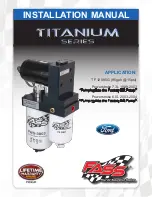
Only shift from DRIVE to PARK or REVERSE when the
accelerator pedal is released and the vehicle is stopped.
Be sure to keep your foot on the brake pedal when
shifting between these gears.
The transmission shift lever has PARK, REVERSE, NEU-
TRAL, DRIVE, and AutoStick® (+/-) shift positions. Manual
shifts can be made using the AutoStick® shift control (refer
to “AutoStick®” in this section for further information).
Toggling the shift lever rearward (+) or forward (-) while in
the AutoStick® position (beside the DRIVE position) will
manually select the transmission gear, and will display the
current gear in the instrument cluster as 1, 2, 3, etc.
NOTE:
If the shift lever cannot be moved to the PARK,
REVERSE, or NEUTRAL position (when pushed forward)
it is probably in the AutoStick® (+/-) position (beside the
DRIVE position). In AutoStick® mode, the transmission
gear (1, 2, 3, etc.) is displayed in the instrument cluster.
Move the shift lever to the right (into the DRIVE [D]
position) for access to PARK, REVERSE, and NEUTRAL.
Gear Ranges
DO NOT race the engine when shifting from PARK or
NEUTRAL into another gear range.
NOTE:
After selecting any gear range, wait a moment to
allow the selected gear to engage before accelerating.
This is especially important when the engine is cold.
PARK (P)
This range supplements the parking brake by locking the
transmission. The engine can be started in this range.
Never attempt to use PARK while the vehicle is in
motion. Apply the parking brake when leaving the
vehicle in this range.
When parking on a level surface, you may shift the
transmission into PARK first, and then apply the parking
brake.
When parking on a hill, apply the parking brake before
shifting the transmission to PARK, otherwise the load on
436 STARTING AND OPERATING
Summary of Contents for 2015 Dart
Page 1: ...Dart O W N E R S M A N U A L 2 0 1 5 I n f o r ma t i o nP r o v i d e db y ...
Page 4: ...I n f o r ma t i o nP r o v i d e db y ...
Page 7: ...1 INTRODUCTION 5 I n f o r ma t i o nP r o v i d e db y ...
Page 10: ...I n f o r ma t i o nP r o v i d e db y ...
Page 161: ...3 UNDERSTANDING THE FEATURES OF YOUR VEHICLE 159 I n f o r ma t i o nP r o v i d e db y ...
Page 162: ...160 UNDERSTANDING THE FEATURES OF YOUR VEHICLE I n f o r ma t i o nP r o v i d e db y ...
Page 163: ...3 UNDERSTANDING THE FEATURES OF YOUR VEHICLE 161 I n f o r ma t i o nP r o v i d e db y ...
Page 204: ...202 UNDERSTANDING THE FEATURES OF YOUR VEHICLE I n f o r ma t i o nP r o v i d e db y ...
Page 206: ...204 UNDERSTANDING THE FEATURES OF YOUR VEHICLE I n f o r ma t i o nP r o v i d e db y ...
Page 218: ...216 UNDERSTANDING THE FEATURES OF YOUR VEHICLE I n f o r ma t i o nP r o v i d e db y ...
Page 220: ...218 UNDERSTANDING THE FEATURES OF YOUR VEHICLE I n f o r ma t i o nP r o v i d e db y ...
Page 222: ...220 UNDERSTANDING THE FEATURES OF YOUR VEHICLE I n f o r ma t i o nP r o v i d e db y ...
Page 224: ...222 UNDERSTANDING THE FEATURES OF YOUR VEHICLE I n f o r ma t i o nP r o v i d e db y ...
Page 302: ...I n f o r ma t i o nP r o v i d e db y ...
Page 477: ...5 STARTING AND OPERATING 475 I n f o r ma t i o nP r o v i d e db y ...
Page 564: ...I n f o r ma t i o nP r o v i d e db y ...
Page 622: ...I n f o r ma t i o nP r o v i d e db y ...
Page 630: ...I n f o r ma t i o nP r o v i d e db y ...
Page 641: ...INDEX 10 I n f o r ma t i o nP r o v i d e db y ...
















































